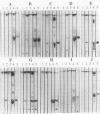Abstract
Because of the rising incidence of clinical mycobacterial infections and the difficulty in identification and characterization of mycobacteria at the subspecies and serovar levels, a technique for differentiation that could be performed quickly and with relatively little equipment and expense was developed. Lysis and fractionation of mycobacteria by matrix solid-phase dispersion followed by thin-layer chromatography were used to produce chemotype profiles of the lipid and glycolipid components of each isolate. Organisms tested included Mycobacterium scrofulaceum, Mycobacterium phlei, Mycobacterium smegmatis, Mycobacterium flavescens, Mycobacterium kansasii, Mycobacterium bovis, 11 isolates of Mycobacterium gordonae, 10 serovars of Mycobacterium avium, and four strains of Mycobacterium paratuberculosis. A relative retention (Rx) value was established for each visible band on the chromatographs by comparison with a band common to all organisms tested. The chemotype profiles produced were different for every separate species and serovar sampled. These findings suggest that matrix solid-phase dispersion and subsequent thin-layer chromatography may have the sensitivity and flexibility to characterize and identify mycobacteria at the species and subspecies levels and potentially to identify clinical isolates of mycobacteria that have been difficult to identify by standard means. The technique has certain advantages over current biochemical, immunologic, and genetic methods because it is relatively simple to perform, is inexpensive, and requires a small amount of bacterial sample.
Full text
PDF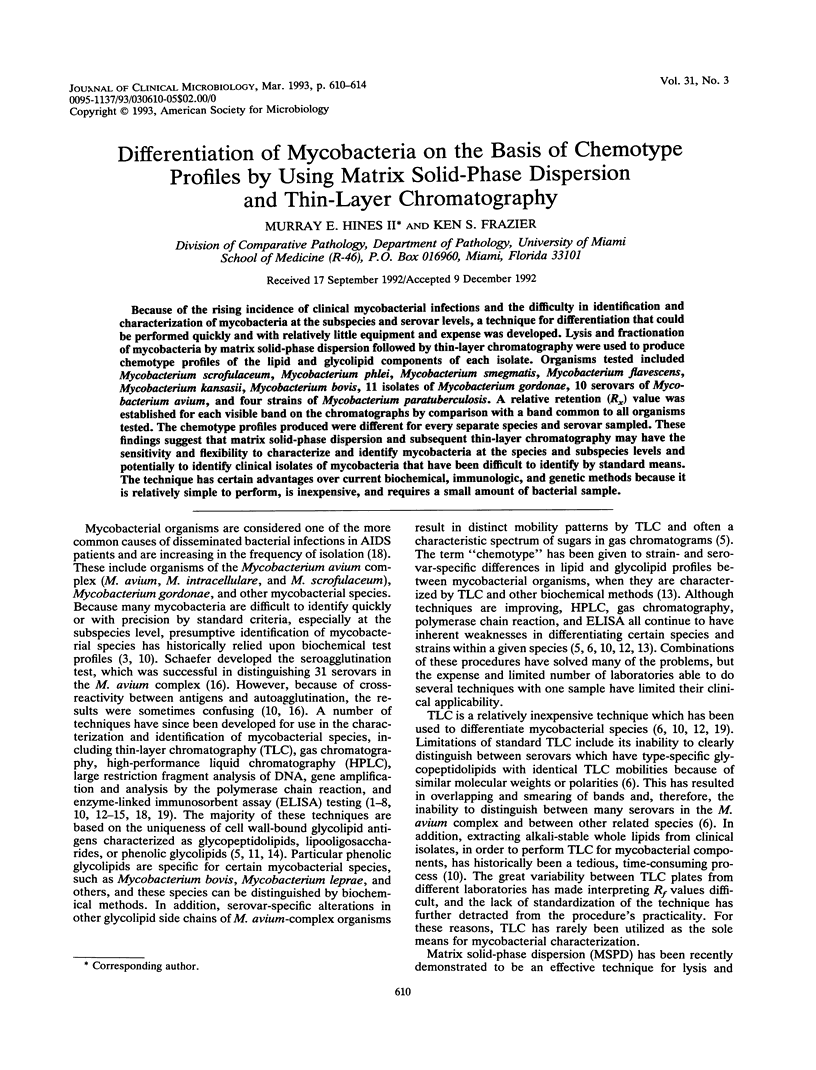
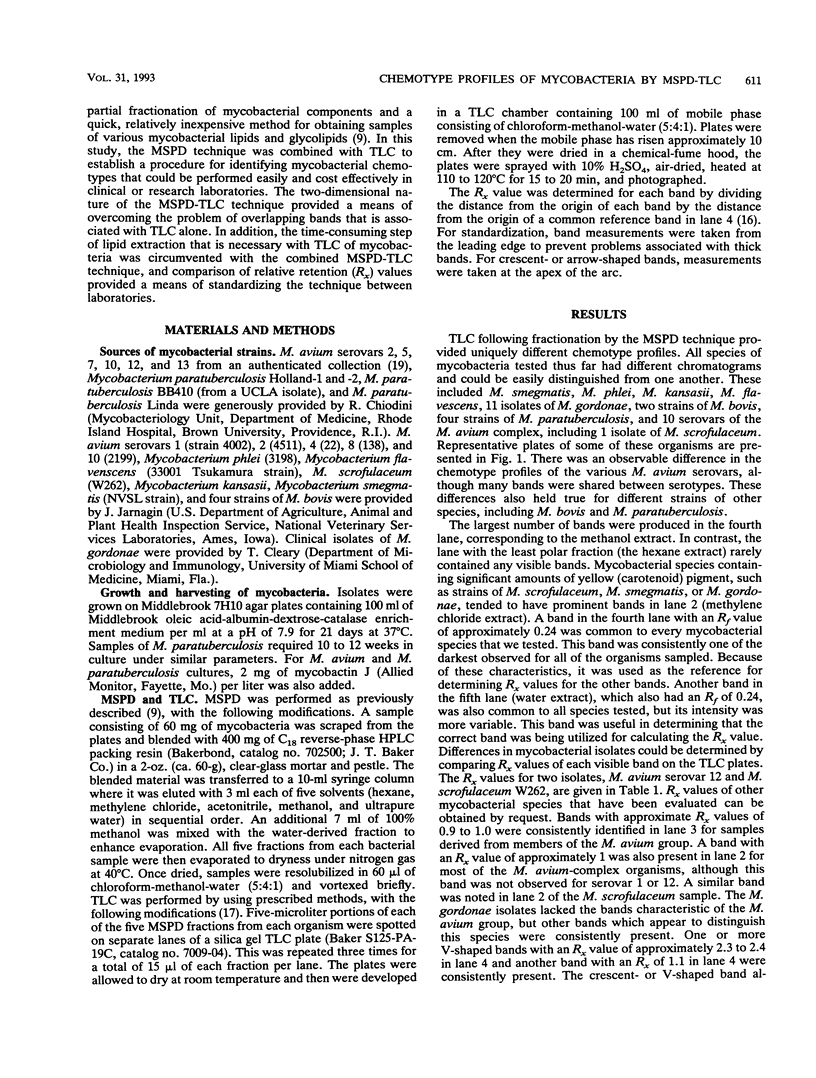

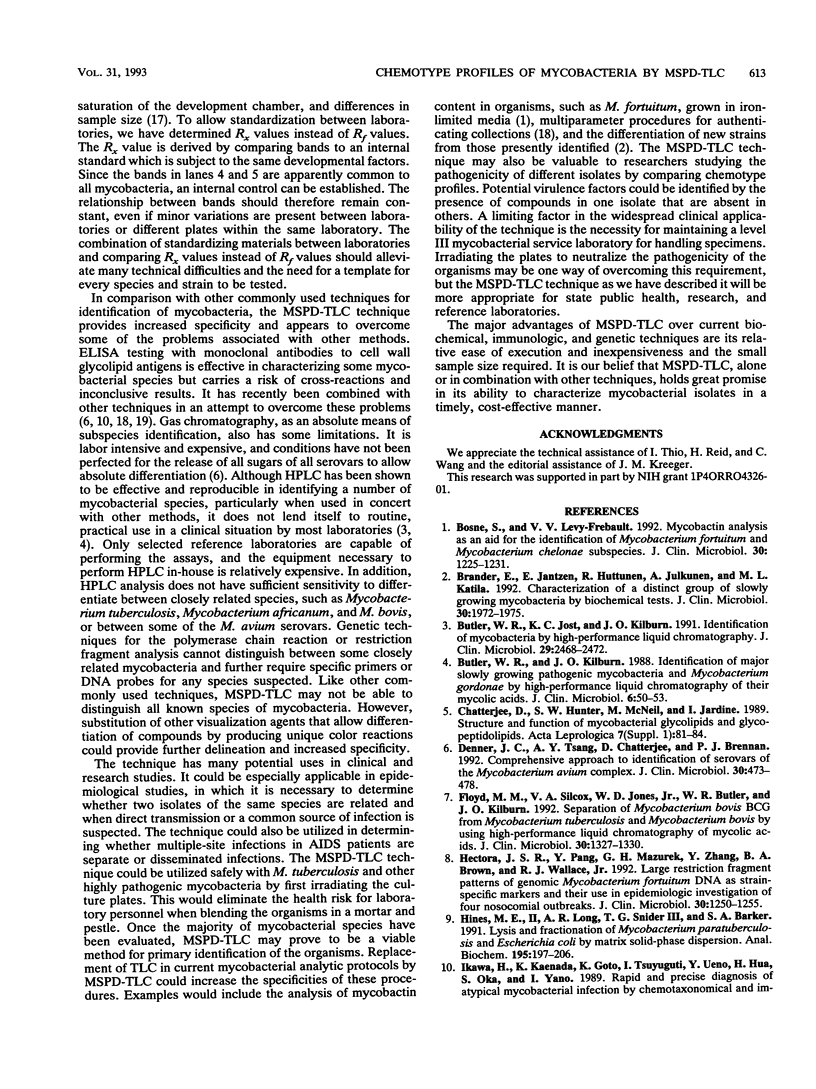
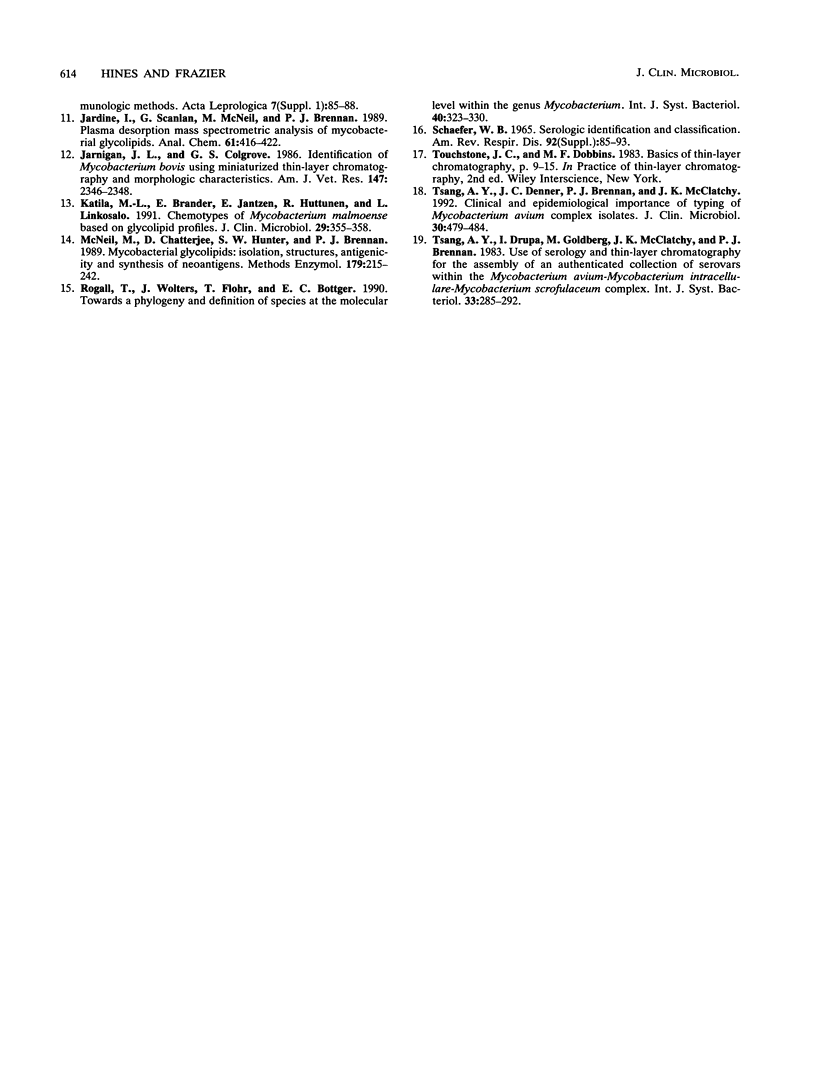
Images in this article
Selected References
These references are in PubMed. This may not be the complete list of references from this article.
- Bosne S., Lévy-Frébault V. V. Mycobactin analysis as an aid for the identification of Mycobacterium fortuitum and Mycobacterium chelonae subspecies. J Clin Microbiol. 1992 May;30(5):1225–1231. doi: 10.1128/jcm.30.5.1225-1231.1992. [DOI] [PMC free article] [PubMed] [Google Scholar]
- Brander E., Jantzen E., Huttunen R., Julkunen A., Katila M. L. Characterization of a distinct group of slowly growing mycobacteria by biochemical tests and lipid analyses. J Clin Microbiol. 1992 Aug;30(8):1972–1975. doi: 10.1128/jcm.30.8.1972-1975.1992. [DOI] [PMC free article] [PubMed] [Google Scholar]
- Butler W. R., Jost K. C., Jr, Kilburn J. O. Identification of mycobacteria by high-performance liquid chromatography. J Clin Microbiol. 1991 Nov;29(11):2468–2472. doi: 10.1128/jcm.29.11.2468-2472.1991. [DOI] [PMC free article] [PubMed] [Google Scholar]
- Butler W. R., Kilburn J. O. Identification of major slowly growing pathogenic mycobacteria and Mycobacterium gordonae by high-performance liquid chromatography of their mycolic acids. J Clin Microbiol. 1988 Jan;26(1):50–53. doi: 10.1128/jcm.26.1.50-53.1988. [DOI] [PMC free article] [PubMed] [Google Scholar]
- Chatterjee D., Hunter S. W., McNeil M., Jardine I., Brennan P. J. Structure and function of mycobacterial glycolipids and glycopeptidolipids. Acta Leprol. 1989;7 (Suppl 1):81–84. [PubMed] [Google Scholar]
- Denner J. C., Tsang A. Y., Chatterjee D., Brennan P. J. Comprehensive approach to identification of serovars of Mycobacterium avium complex. J Clin Microbiol. 1992 Feb;30(2):473–478. doi: 10.1128/jcm.30.2.473-478.1992. [DOI] [PMC free article] [PubMed] [Google Scholar]
- Floyd M. M., Silcox V. A., Jones W. D., Jr, Butler W. R., Kilburn J. O. Separation of Mycobacterium bovis BCG from Mycobacterium tuberculosis and Mycobacterium bovis by using high-performance liquid chromatography of mycolic acids. J Clin Microbiol. 1992 May;30(5):1327–1330. doi: 10.1128/jcm.30.5.1327-1330.1992. [DOI] [PMC free article] [PubMed] [Google Scholar]
- Hector J. S., Pang Y., Mazurek G. H., Zhang Y., Brown B. A., Wallace R. J., Jr Large restriction fragment patterns of genomic Mycobacterium fortuitum DNA as strain-specific markers and their use in epidemiologic investigation of four nosocomial outbreaks. J Clin Microbiol. 1992 May;30(5):1250–1255. doi: 10.1128/jcm.30.5.1250-1255.1992. [DOI] [PMC free article] [PubMed] [Google Scholar]
- Hines M. E., 2nd, Long A. R., Snider T. G., 3rd, Barker S. A. Lysis and fractionation of Mycobacterium paratuberculosis and Escherichia coli by matrix solid-phase dispersion. Anal Biochem. 1991 Jun;195(2):197–206. doi: 10.1016/0003-2697(91)90317-m. [DOI] [PubMed] [Google Scholar]
- Ikawa H., Kaneda K., Goto K., Tsuyuguti I., Ueno Y., Hua H., Oka S., Yano I. Rapid and precise diagnosis of atypical mycobacterial infection by chemotaxonomical and immunological methods. Acta Leprol. 1989;7 (Suppl 1):85–88. [PubMed] [Google Scholar]
- Jardine I., Scanlan G., McNeil M., Brennan P. J. Plasma desorption mass spectrometric analysis of mycobacterial glycolipids. Anal Chem. 1989 Mar 1;61(5):416–422. doi: 10.1021/ac00180a008. [DOI] [PubMed] [Google Scholar]
- Jarnagin J. L., Colgrove G. S. Identification of Mycobacterium bovis, using miniaturized thin-layer chromatography and morphologic characteristics. Am J Vet Res. 1986 Nov;47(11):2346–2348. [PubMed] [Google Scholar]
- Katila M. L., Brander E., Jantzen E., Huttunen R., Linkosalo L. Chemotypes of Mycobacterium malmoense based on glycolipid profiles. J Clin Microbiol. 1991 Feb;29(2):355–358. doi: 10.1128/jcm.29.2.355-358.1991. [DOI] [PMC free article] [PubMed] [Google Scholar]
- McNeil M., Chatterjee D., Hunter S. W., Brennan P. J. Mycobacterial glycolipids: isolation, structures, antigenicity, and synthesis of neoantigens. Methods Enzymol. 1989;179:215–242. doi: 10.1016/0076-6879(89)79123-0. [DOI] [PubMed] [Google Scholar]
- Rogall T., Wolters J., Flohr T., Böttger E. C. Towards a phylogeny and definition of species at the molecular level within the genus Mycobacterium. Int J Syst Bacteriol. 1990 Oct;40(4):323–330. doi: 10.1099/00207713-40-4-323. [DOI] [PubMed] [Google Scholar]
- Schaefer W. B. Serologic identification and classification of the atypical mycobacteria by their agglutination. Am Rev Respir Dis. 1965 Dec;92(6):85–93. doi: 10.1164/arrd.1965.92.6P2.85. [DOI] [PubMed] [Google Scholar]
- Tsang A. Y., Denner J. C., Brennan P. J., McClatchy J. K. Clinical and epidemiological importance of typing of Mycobacterium avium complex isolates. J Clin Microbiol. 1992 Feb;30(2):479–484. doi: 10.1128/jcm.30.2.479-484.1992. [DOI] [PMC free article] [PubMed] [Google Scholar]




